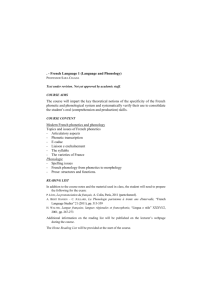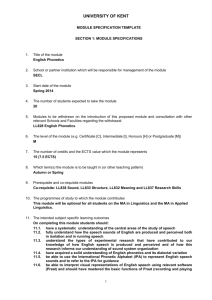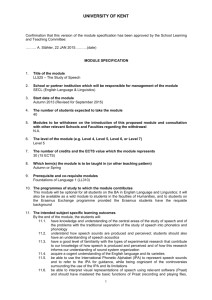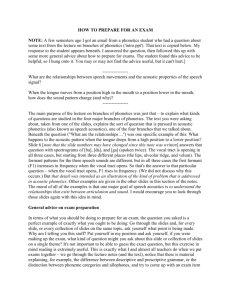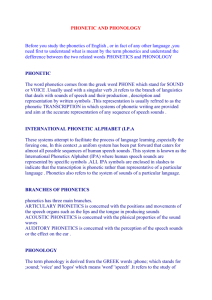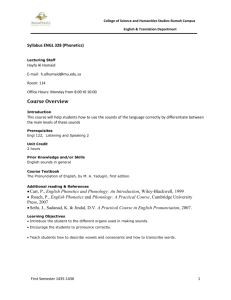Azərbaycan Respublikası Təhsil Nazirliyi
advertisement
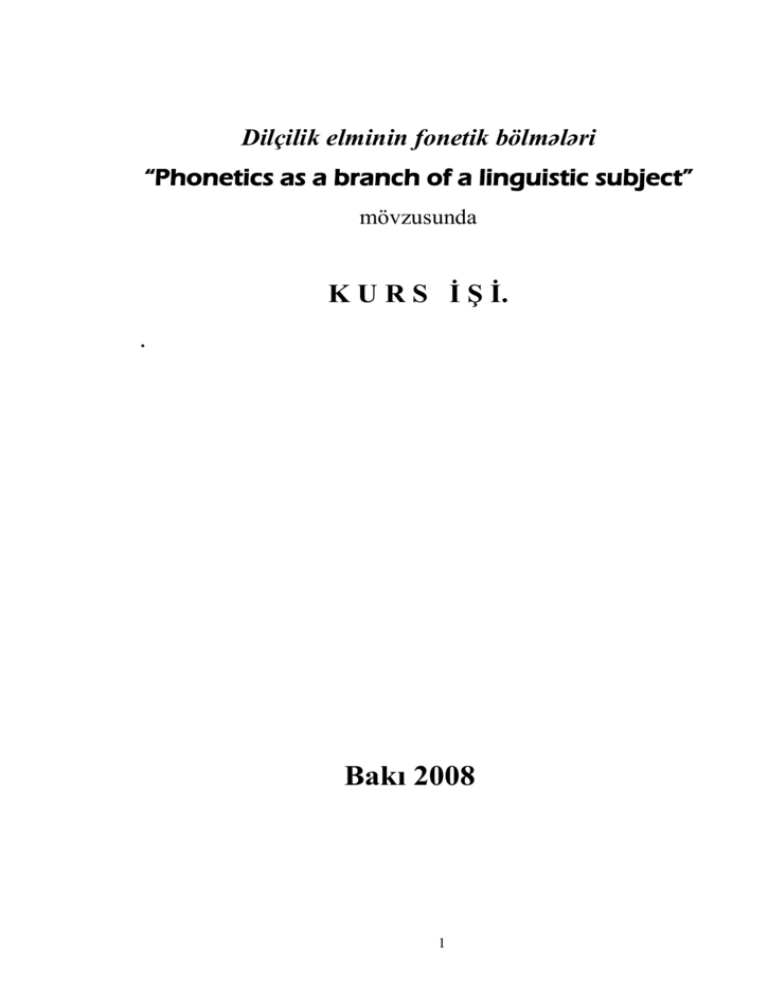
Dilçilik elminin fonetik bölmələri “Phonetics as a branch of a linguistic subject” mövzusunda K U R S İ Ş İ. . Bakı 2008 1 CONTENTS: 1. Itroduction _______________ 3 2. General Information About Phonetic ______________ 4 3. Classification of Phonemes _______________ 11 4. Phonetic as a Branch of a Linguistic Subject ___________ 21 5. Conclusion ___________ 29 6. The list of Literature ______________ 30 INTRODUCTION 2 The most important function of any language is to serve for intercourse. No thought, no idea can be xpressed without sentences which consist of words. Spoken words in all the languages consist of sounds. Letters are used to represent spoken words in writing only. Therefore any spoken language is firstly of all a language of sounds. In order to speak any language one must be able to pronounce words and sentences in that language correctly. It means that the leaners of foreign language must first of all know how to pronounce isolated sounds, learn to join them within words and sentences. They must also know how sounds are modified in speech, which of the elements in words and sentences must be stressed and what intonation is used to express a certain thought. Teachers of a foreign language must not only speak and read correctly, but also know how to teach correct pronunciation. The teacher must also know all the difficulties that may arise in teaching good pronunciation and possess methods of overcoming these difficulties. Now speech habits are attained by learning and remembering the articulation of new speech sounds and other phenomena, then by systematic training on the basis of special sets of exercises in order to make new speech habits stable. Part _1 General information about phonetic. 3 The word “phonetic” is derived from the Greek and is used in two different meanings: 1) to some authors, usually non –phoneticians, phonetics is that part of grammar which deals with speech sound; 2) to phoneticians, however, phonetics is an independent branch of linguistics which is concerned with the phonetic structure of language. Within the last few decades, the ever increasing recognition of the importance of phonetic in the study of a language, has led to great achievements in the field of phonetics. The development of the theory of phonemes, for instance, has caused a revolution, we may say, in the treatment of many phonetic phenomena. A number of other important phonetic concepts have been developed; it is therefore possible to assert that phonetics should no longer be considered a part of grammar. It is an independent branch of linguistics that has, in its turn, developed branch of linguistics that has, in its turn, developed branches of its own. However, phonetics, being a branch of linguistics, occupies a peculiar position. On the one hand, it is quite independent, and develops according to its own laws. To –day the sphere of phonetics is wider and deeper than ever before: phonemes and their distribution in words, their mutual adaptation, stress, syllable formation, intonation, the relation between oral and written speech and a number of other problems have become objects of phonetic investigation. On the other hand phonetics is closely connected with a number of other sciences, such as physics (or rather acoustics), biology, physiology and others. The more phonetics develop, the more various 4 branches of science become involved in the field of phonetic investigation. Phonetics is an essential part of language because it gives language a definite form; - the vocabulary and grammar of a language can function only when the language has phonetic form. Hence, grammar and vocabulary depend on phonetics; they cannot exist outside of phonetics, because all lexical and grammatical phenomena are expressed phonetically. Thus although phonetics serves as a means of expressing grammatical and lexical phenomena, yet it has laws of its own which are independent of grammar and vocabulary. The following examples will illustrate this: 1. Words are expressed in phonetic form, and can be analysed into sounds. One word may differ from another in one sound only, e.g. big [ ], bag [ ], bog [ ]. 2. The three main forms of the so –called “strong” (or “irregular” or “non –standard” or “vocalic”) verbs in English which are the result of a long historical development of the English language, are also expressed in phonetic form, and differ from one another because of vowel alternations in the root: Rise – rose – risen [ ] Swim – swam – swum [ ] Branches of Phonetics Phonetic is not a new science. It was known to the ancient Greeks and to the ancient Hindus. The scientists of that time were concerned with speech sound only. It may be said that the 5 orthography of all written languages which use alphabets developed in the course of a very detailed and sometimes very adequate phonetic analysis. Nevertheless, phonetics, as an independent science, began to develop in western Europe and Russia only in the 19th century. There has been considerable progress and growth in the 20th century. Within the last half century especially, new concepts have sprung up, new theories and new schools have come into existence, new methods of investigation have been developed. Not only has the sphere of investigation in phonetics become widened, but several new branches of phonetics have also arisen. The most important of these are special phonetics and general phonetics. Special phonetics may be subdivided into descriptive phonetics and historical phonetics. Special phonetic is concerned (1) with the study of the phonetic structure of one language only, in its static form, at a particular period, synchronically (descriptive phonetics); (2) with the study of the phonetic structure of a language in its historical development, diachronically (historical phonetics). General phonetics is based on the extensive material which the special phonetics of great number of languages provides; it is also based on other sciences, such as physics, biology, psychology, speech pathology, etc. As a result of the fact that it derives most of its factual material from special phonetics, general phonetics has been able to make a number of general conclusions concerning the complex nature of speech sound, it has been able to analyse speech sounds from different points of view and to formulate a number of important theories: the phoneme theory, the theory of syllable formation, 6 theories connected with syntagm, stress, intonation, graphical rules and rules of orthography, etc. The development of new methods in telephony, the keen interest in the acoustic aspect of speech sound recently displayed by many linguists, the universal tendency to solve purely linguistic problems by means of complex apparatus has resulted in the rapid development of what is now termed acoustic phonetics. All instrumental experimentation is treated as a method of investigation. Phonetics has a wide sphere of application. It is used in teaching children to read and write their mother tongue. It would be very difficult to do that without a through understanding of the intricate relations between sounds and letters. The creation of new orthographies for hitherto unwritten languages and the improvement of already existing orthographies also presuppose careful phonetic investigation. Many languages of the Soviet Union have recently received their orthographies for the first time in their history. Russian spelling was also revised and greatly improved during the first post –revolutionary years. Phonetics and phonology. During the last twenty years the term “phonetics” has become somewhat ambiguous. This is largely due to the Prague School of Linguistics which propagates a new science phonology, - that is to be differentiated from phonetics. According to the conceptions of the Prague School, phonetics and phonology are two independent branches of science. Phonetics is a biological science, and is concerned with the physical and physiological characteristics of speech sound. 7 Phonology is a linguistic science and is concerned with the social functions of different phonetic phenomena. The Prague School of Linguistics has many adherents. Phonology is a convenient term to indicate that section of phonetics in which the social functions of speech sounds are discussed. It does not seem logical, however to separate function from phonetic form thus completely excluding phonetics is treated as an inseparable part of linguistics and is not presented as opposed to phonology in any way. Three Aspects of Speech Sounds Speech sounds are of a complex nature and have three different aspects: (1) acoustic; (2) biological; (3) linguistic. 1. Sounds can be analysed from the acoustic point of view. Being acoustic phenomena they share their properties with other acoustic phenomena. They like any other sounds speech sounds are communicated to the air in the form of sound waves. Speech sounds can be investigated by the same method as any other sound and are subject to the same acoustic laws. 2. Speech sounds may also be considered from the biological point of view as phenomena resulting from the activities of the speech organs. That part of phonetics which is concerned with the work of the speech organs their ability to form definite speech sounds was termed anthropophonetics by I. A. Baudouin de Courtenay. 3. it is clear from the above that speech sounds are acoustic as well as biological phenomena: however it is their third aspect, the 8 linguistic aspect, that made them the subject of linguistic investigation. One or another acoustic or logical characteristic of speech sounds (stress, syllable, or some other sound feature in a language) can arouse the interest of linguists in proportion to its linguistic significance only. In other words, it is not enough to be able detect, by means of experiment and observation, the minutest sound features, one should be able to determine in what way or way speech sound can function as significant sound units or phenonemes. Methods of Investigation The method of investigation used in phonetics vary, but there are three principal methods: (1) the direct observation method; (2) the linguistic method; (3) the experimental method. 1. The direct observation method comprises three important modes of phonetic analysis: by ear, by sight and by muscular sensation. Investigation by means of this method can be effective only if the persons employing it have been specially trained to observe the minutest movements of their own and other people’s speech organs, and to distinguish the slightest variations in sound quality. The muscular sensation is developed by constant and regular practice in articulating various sounds. A trained phonetician should be able to pronounce sounds of a given quality as well as to recognize, 9 by means of his highly developed muscular sensation the exact nature of the articulation of any speech sound that he hears. 2. The aim of linguistic method of investigation of many concrete phonetic phenomena, such as sound, stress, intonation or any other feature, is to determine in what way all of these phonetic features are used in a language to convey a certain meaning. 3. The experimental method is based, as a rule, upon the use of special apparatus or instruments, such as the laryngoscope, the artifical palate, the kymograph, the magnetic tape recorder the oscillagraph, the spectragh. Lately X –ray photograpy and slow motion films, as well as speech synthethizers, have been introduced in phonetic investigation, and very interesting results have been obtained. Part _2 Classification of phonemes. To know how sound are produced by speech organs is not enough to describe and classify them as language units. When we talk about the sounds of language, the term “sound” can be interpreted in two rather different ways. In the first place, we can say that [t] and [d] are two different sounds in English, [t] being fortis and [d] being lenis and we can illustrate this by showing how they contrast with each other to make a difference of meaning in a large number of pairs, such as tie – die, seat – seed, etc. But on the another hand if we listen carefully to the [t] in let us and compare it with the [t] in let them we can hear that the two sounds are also not the same, the [t] of let us is alveolar, while the [t] of let them is dental. In both examples the 10 sounds differ in one articulatory feature only; in the second case the difference between the sounds has functionally no significance. It is perfectly clear that the sense of “sound” in these two cases is different. To avoid this ambiguity, the linguist uses two separate terms: “phoneme” is used to mean “sound” in its contrastive sense, and “allophone” is used for sounds which are variants of phoneme: they usually occur in different positions in the word and hence cannot contrast with each other, nor be used to make meaningful distinctions. As you probably know from the course of general linguistics, the definitions of the phoneme vary greatly. The truly materialistic view of the phoneme was originated by the Soviet linguist L. V. Shcherba. According to Shcherba the phoneme may be viewed as a functional, material and abstract unit. These three aspect of the phoneme are concentrated in the definition of the phoneme suggested by V. A. Vassilyev, who looks upon the phoneme as “… a dialectical unity of these aspects because they determine one another and are thus interdependent” The only drawback of this definition is that it is too long and complicated for practical use. The concise form of it could be: The phoneme is a minimal abstract linguistic unit realized in speech in the form of speech sounds opposable to other phonemes of the same language to distinguish the meaning of morphemes and words. Let us consider the phoneme from the point of view if its three aspects. Firstly, the phoneme is a functional unit. As you know from the above in phonetics function is usually understood to mean 11 discriminatory function, that is, the role of the various components of the phonetic system of the language in distinguishing one morpheme from another, one word from another or also one utterance from another. The opposition of phonemes in the same phonetic environment differentiates the meaning of morphemes and words, e.g. said – says, sleeper –sleepy, bath –path. Sometimes the opposition of phonemes serves to distinguish the meaning of the whole phrases, e. g. He was hear badly – He was hurt badly. Thus we may say that the phoneme can fulfil the distinctive function. Secondly, the phoneme is material, real and objective. That means that it is realized in speech of all English –speaking people in the form of speech sound, its allophones. The sets of speech sounds, that is the allophones belonging to the same phoneme are not identical in their articulatory content though there remains some phonetic similarity between them. Consequently, though allophones of the same phoneme possess similar articulatory features they may frewuently show considerable phonetic differences. It is perfectly obvious that in teaching English pronunciation the difference between the allophones of the same phoneme should be necessarily considered. The starting point is of course the articulation of the principal allophone, e. g. /d –d –d/: door, double, daughter, dark, etc. special training of the subsidiary allophones are generally paid equals attention to. In teaching the pronunciation of [ d ], for instance, it is hardly necessary to concentrate on an allophone such as [ d ] 12 before a front vowel as in Russian similar consonant in this position are also palatalized. Neither is it necessary to practice specially the labialized [ d ] after the labial [ w ] because in this position [ d ] cannot be pronounced in any other way. Carefully made up exercises will exclude the danger of foreign accent. Allophones are arranged into functionally similar groups, that is groups of sounds in which the members of each group are not opposed to one another, but are opposable to members of any other group to distinguish meaning in otherwise similar sequences. Consequently allophones of the same phoneme never occur in similar phonetic contexts, and thus are entirely predictable according to the phonetic environment, and thus carry no useful information, that is they cannot differentiate meanings. But the phones which are realized in speech do not correspond exactly to the allophone predicted by this or that phonetic environment. They are modified by phonostylistic, dialectal and individual factors. In fact, no speech sounds are absolutely alike. Thirdly, allophones of the same phoneme, no matter how different their articulation may be, function as the same linguistic unit. The question arises why phonetically naïve native speakers seldom observe differences in the actual articulatory qualities between the allophones of the same phonemes. The speaker is quite readily aware of the phonemes of his language but much less aware of the allophones: it is possible in fact that he will not hear the difference between two allophones like the alveolar and dental consonant [ d ] in the words bread and breadth 13 even when a distinction is pointed out; a certain amount of ear – training may be needed. The reason is that the phonemes have an important function in the language: they differentiate words like tie and die from each other, and to be to hear and produce phonemic differences is part of what it means to be a competent speaker of the language. For example the dark [l] occur following a vowel as in pill, cold, but it is not found before a vowel, whereas the clear [l] only occurs before a vowel, as in lip, like. These two vowels cannot therefore contrast with each other in the way that [l] contrast with [r] in lip – rip or lake –rake, there are no pair of words which differ only in that one has [l] and the other –[l]. Native speakers do not observe the difference between the allophones of the same phoneme. At the same time they realize, quite subconsciously of course, that allophones of each phoneme possess a bundle of distinctive features, that makes this phoneme functionally different from all other phonemes of the language concerned. This functionally relevant bundle of articulatory features is called the invariant of the phoneme. Neither of the articulatory features that from the invariant of the phoneme can be changed without affecting the meaning. All the allophones of the phoneme [d], for instance, are occlusive, forelingual, lenis. If occlusive articulation is changed for constrictive one [d] will be replaced by [z], cf. breed – breeze, bid –bit. That is why it is possible to state that occlusive, forelingual and lenis characteristics of the phoneme [d] are generalized in the mind of the speaker into what is called the invariant of this phoneme. 14 The articulatory features which form the invariant of the phoneme are called distinctive or relevant. To extract relevant feature of the phoneme we have to oppose it to some other phoneme in the same phonetic context. If the opposed sounds differ in one articulatory feature and this difference brings about changes in the meaning of the words the contrasting features are called relevant. For example, the words port and court differ in one consonant only, that is the word port has the initial consonant [p], and the word court begins with [k]. both sounds are occlusive and fortis, the only difference being that [p] is labial and [k] is backlingual. Therefore it is possible to say that labial and backlingual articulations are relevant in the system of English consonants. The articulatory features which do not serve to distinguish meaning are called non –distinctive, irrelevant or redundant; for instance, it is impossible in English to oppose an aspirated [p] to a non –aspirated one in the same phonetic context to distinguish meanings. That is why aspiration is a non –distinctive feature of English consonant. As it has been mentioned above any change in the invariant of the phoneme affects the meaning. Naturally, anyone who studies a foreign language makes mistakes in the articulation of particular sounds. L.V. Shcherbe classifies the pronunciation errors as phonological and phonetic. NOTATION 15 It is interesting at this stage to consider the system of phonetic notation which is generally termed as “transcription”. Transcription is a set of symbols representing speech sounds. The symbolization of sounds naturally differs according to whether the aim is to indicate the phoneme, i. e. a functional unit as a whole, or to reflect the modifications of its allophones as well. The International Phonetic Association (IPA) has given accepted values to an inventory of symbols, mainly alphabetic but with additions. “Agreed values” means, for example that the symbol [g] represents a lenis backlingual stop as in gate and not the orthographic “g” of gin, which is notated as [d ]. The first type of nation, the broad or phonemic transcription, provides special symbols for all the phonemes of language. The second type, the narrow or allophonic transcription, suggests special symbols including some information about articulatory activity of particular allophonic features. The broad transcription is mainly used for practical expedience, the narrow type server the purposes of research work. Phonetic transcription is a good basis for teaching the pronunciation of a foreign language, being a powerful visual aid. To achieve good results it is necessary that the learners of English should associate each relevant difference between the phonemes with special symbols, that is each phoneme should have a special symbol, if not, the difference between the pairs of sounds above may be wrongly associated with vowel length which is non –distinctive (redundant) in modern English. 16 MAIN TRENDS IN PHONEME THEORY Most linguists have looked upon the phoneme as one of the basic language units. But not all of them have described it in the same way. The majority of them agree that the phoneme serves to distinguish morphemes and words thus being a functional unit. However, some of them define it in purely “psychological” terms, others prefer physically grounded definitions. Same scholars take into consideration only the abstract aspect of the phoneme, others stick only to its materiality. This has divided the various “schools” of phonology some of which will be discussed below: View of the phoneme seem to seem to fall into four main classes. The “mentalistic” or “psychological” view regards the phoneme as an ideal “mental image” or a target at which the speaker aims. He deviates from this ideal sound partly because an identical repetition of a sound is next to impossible and partly because of the influence exerted by neighbouring sounds. According to this conception allophones of the phoneme are varying materializations of it. This view was originated by the founder of the phoneme theory, the Russian linguist I.A. Baudauin de Courtenay and something like it appears to have been adopted by E.D. Sapir. The same point of view was shared by other linguists, Alf. Sommerfelt (76) for one, who described phonemes as “models which speakers seek to reproduce”. The functional view of the phoneme gave rise to a branch of linguistics called “phonology” or “phonemics” which is concerned with 17 relationships between contrasting sounds in a language. Its special interest lies in establishing the system of distinctive features of the language concerned. Phonetics is limited in this case with the precise description of acoustic and physiological sounds without any concern to their linguistic function. The supporters of this conception even recommend to extract phonetics from linguistic disciplines which certainly cannot be accepted by Soviet phoneticians. A stronger form of the “functional” approach is advocated in the so –called “abstract” view of the phoneme, which regards phonemes as essential independent of the acoustic and physiological properties associated with them that is of speech sounds. This view of the phoneme was pioneered by L. Hjelmslev and his associates in the Copenhagen Linguistic Circle, H.J. Uldall and K. Togby. The views of the phoneme discussed above can be qualified as idealistic since all of them regard the phoneme as an abstract conception existing in the mind but not in the reality, that is in himan speech, speech sounds being only phonetic manifestations of these conceptions. The “physical” view regards the phoneme as a “family” of related sounds satisfying certain conditions notably: 1. The various members of the “family” must show phonetic similarity to one another, in other words be related in character. 2. No member of the “family” may occur in the same phonetic context as any other. THE SYSTEM OF ENGLISH PHONEMES 18 In this section we are going to give a brief and readable description of the problems which scholars face trying to describe the English sounds from the functional point of view. We shall try to explain what is understood by quality of a sound, what articulatory characteristics may be considered constituents of quality and to determine which of them are important enough to arrest our attention as phonologically relevant. By way of introduction we would like to remind you that there are two major classes of sounds traditionally distinguished by phoneticians in any language. They are termed consonants and vowels. It would be fair to mention that the distinction is based mainly on auditory effect. Consonants are known to have voice and noise combined, while vowels are sounds consisting of voice only. From the articulatory point of view the difference is due to the work of speech organs. In case of vowels no obstruction is made. In case of consonants various obstructions are made. So consonants are characterized by so –called close articulation, that is by a complete, partial or intermittent blockage of the air –passage by an organ or organs. The closure is formed in such a way that the air –stream is blocked or hindered or otherwise gives rise to audible friction. As a result consonants are sounds which have noise as their indispensable and most defining characteristic. Part _3 Phonetics as a branch of a linguistic subject 19 Phonetics began long before there were either grammar or linguistics. Ancient objects, drawings, and written documents show that voice and speech always fascinated men. Written documents and evidences from the ancient civilizations point to an awareness of speech, its origin and abnormalities a long time ago. Here are some data connected with the history of phonetic development: 1829 laryngoscope was invented, 1852 first observation of the vocal cords were made, 1877 gramophone was invented, 1886 International Phonetic Association (IPA) was founded. IPA started publications of a special phonetic magazine “Le Maitre Phonetique”. It stated phonetic symbols for sounds of many existing language. For the sounds of the English language IPA suggested the following broad and narrow transcription symbols: Broad Narrow Phonetics is an independent branch of linguistics like lexicology, grammar and stylistics. It studies not only separate sounds but their functions as well. It also studies the relation between written and 20 spoken language. Phonetics is connected with other, non –linguistic sciences; acoustics, physiology, psychology, logic, etc. Phonetics has branches of its own. The most important of them are special phonetics and general phonetics. The aim of special phonetics is to study the sounds of one language at a particular period of time, that is synchronically or diachronically, that is to study the sounds of a language in its historical development. General phonetics studies the sound system of several languages. It is part of general linguistics. The connection of phonetics with grammar, lexicology and stylistics is exercised first of all via orthography which in its turn is very closely connected with phonetics. Phonetics formulates the rules of pronunciation of separate sounds and sound combinations. The rules of reading are based on the relation of sounds to orthography and present certain difficulties in learning the English language, especially on the initial stage of studying. Thus, vowel sounds, for instance, are pronounced not only as we name the letters corresponding to them: the letter “u” as (j) u; the letter “o” as (ou); but “a” can be pronounced as: etc. One of the most important phonetic phenomena –sound interchange -is another manifestation of the connection of phonetics with grammar. For instance, this connection can be observed in the category of number. Thus, the interchange of /f –v/, /s –z/, / - / helps to differentiate singular and plural forms of such nouns as: calf – calves /f –v/, leaf –leaves /f –v/, house –houses /s –z/. 21 Besides, vowel interchange is connected with the tense forms of irregular verbs, for instance: sing –sang –sung; write –wrote –written. Phonetics is also connected with grammar through its intonation component. Sometimes intonation alone can serve to single out the logical predicate of the sentence. Phonetics is also connected with stylistics first of all through intonation and its components: speech melody, word stress, rhythm, pausation and voice tamber which serve to express emotions, to distinguish between different attitudes on the part of the author and speaker. Very often the writer helps the reader to interpret his ideas through special words and remarks such as: a pause, a short pause, angrily, hopefully, gently, incredulously, etc. Phonetics is also connected with stylistics through repetition of words, phrases and sounds. Repetition of this kind serves the bases of rhythm, rhyme and alliteration. Regular recurrence of accented elements, or rhythm, may be used as a special device not 0nly in poetry, but in prose as well. Problems of phonostylistics. Pronunciation is by no means homogeneous. It varies under the influence of numerous factors. These factors lie quite outside any possibility of signaling linguistic meaning so it is appropriate to refer to these factors as extralinguistic. The chapter that follows is based on the idea that information about stylistic variations in learning, understanding and producing language is directly useful for the design, execution and evaluation of teaching phonetics. The branch of phonetics most usually applied for such information is phonostylistics. 22 It is the purpose of this chapter to offer brief, readable and scholarly introduction to the main themes and topics covered by current phonostylistic studies. We should point out right at the beginning that phonostylistic is a rapidly developing and controversial field of study though a great deal of research work has been done in it. It would not be accurate to say that phonostylistics is a new branch of phonetics it is rather a new way of looking at phonetic phenomena. Linguists were until recently not aware of this way of analysis and awareness came only as a result of detailed analysis of spoken speech. Before we go on to describe in detail what the problems and tasks of phonostylistics are we should want to give you some understanding of what gave a mighty impulse to this new way of looking at phonetic phenomena. The point is that during the first half of our century linguists have shown interest in written form of the language and so the emphasis in language study was laid on analyzing written speech. It is only during the last thirty–five years that the situation has changed. It may be said that it was the invention of the tape –recorder and other technical aids that was the real turning point in phonetics and linguistics in general. Linguists got a good opportunity of studying the other form of language realization –spoken speech –the variety which had hitherto been largely or completely ignored. It is not only the absence of mechanical aids which accounts for the lack of linguistic research that has been carried out into this variety of language and the procedure difficulty of obtaining reliable data to investigate. There is however, a further reason. Until quite recently theory and research on language was 23 based on the assumption that it is only the written form of language realization that can serve a reliable object of investigation, while the spoken form is not worthy of selentific analysis because it produces deviation from the literary norm. The principles of this selection and arrangement, the ways of combining the element form what is called “the style”. Style integrates language means constructing the utterance, and at the same time differs one utterance from another. It must be noted that the category of style is not new in linguistics. The branch of linguistics that is primarily concerned with the problems of functional style is called functional stylistics. Stylistics is usually regarded as a specific division of linguistics, as a sister science, concerned not with the elements of the language as such but with their expressive potential. We should point out here that we are not going into details as to the problems of stylistics. We shall only try to show how phonostylistics overlaps with functional stylistics and to explain why there is no simple correspondence between functional and phonetic styles. It has been suggested that a functional style can be defined as a fuctional set of formal patterns into which language means are arranged in order to transmit information. A considerable number of attempts have been made in recent years to work out a classification of functional styles. But in spite of this fact it is still an open question in linguistics. In other words, there is no universal classification that is admitted by all analysts. 24 This fact can be accounted for by the following reasons. As was pointed out earlier, language events take place in situations. The factors that determine the usage of certain language means are quite numerous and various. Their interdependence and interconnection are of complex nature. Consequently it is difficult to decide which of the factors are of primary importance and should be considered the most reliable criterion. As was mentioned above, there exist various classifications of functional styles. The terns that are most commonly dealt with are: scientific style, publicistic style, business style, belles –lettres style and colloquial style. The letter functions predominantly in everyday oral speech though most scholars share the opinion that there is no simple correspondence between the styles and the form of language realization. We have attempted to show what is generally understood by an extralinguistic situation and what components may be considered as its constituents. It is perhaps, easy to see how numerous the main factors determining variation in language usage are. What we are interested in here is variants of phonetic means. A framework for understanding and describing them has to deal with the consonant and decisive features of the situational circumstances of language event that are relevant for phonetic level of analysis. It would be true to say that this problem was given a good deal of attention and there is a lot of data obtained with the help of special investigation. It allows us now to single out a number of factors which result in phonostylistic varieties. They are: 1) the purpose, or the aim of the utterance; 25 2) the speaker’s attitude; 3) the form of communication; 4) the degree of formality; 5) the degree of spontaneity İt should be mentioned right here that the purpose or the aim of the utterance may be called a phonetic style –forming factor. All other factors cause modifications within this or that style and that is why may be referred to as style –modifying factors. Considering the form of communication we should say that nature of participation in the language event results in two possible varieties: a monologue and a dialogue. It should be mentioned here that a distinction between a monologue and dialogue is a fairly conditioned one but we note this distinction for a number of reason. Among the social factors determining the usage of stylistic means it is the formality of situation which is very often referred to. Analyzing extralinguistic factors we should add some more to the above –mentioned ones. They are: the speaker’s individuality, temporal provenance, social provenance, range of intelligibility, sex and age of the speaker. The first thing to know about them is that they are incidental, concominant features. They are characteristics of a language user can not vary, with very little exception, like all the above –mentioned ones. One of the most important style –modifying is the degree of spontaneity. 26 CONCLUSION The basis of the phonetic system of a language is its system of phonemes. A phoneme is a smallest sound –unit of a language capable of distinguishing one word from another word or one grammatical form from of the same word. The number of phonemes in every language is limited. There are 44 phonemes in the English language. In connected speech phonemes are united into various combinations in which they influence one another and change their quality to a certain degree. Such slightly modified speech sounds are 27 termed phonetic variants, or allophones. Phonetic variants cannot differentiate words or grammatical forms of words. The variant of a phoneme which keeps all its principal characteristic features unchanged (it is usually the one pronounced in isolation) is called the principal variant of the phoneme. All the other variants are called subsidiary variants. The wrong use of one phonetic variant instead of another does not change the meaning of the word, but gives it as unusual pronunciation which sounds as a foreign accent in speech. Such mistakes are called phonetic. When phonetic mistakes are numerous in speech they may hamper its understanding. Therefore, when learning a language it is necessary to learn to articulate all the phonetic variant which occur in different sound sequences. The phonetic system of language includes all the phonemes with their variants. LITERATURE 1) O. J. Dickushina “English phonetics” (Baku1965) 2) D. Vasilyev “English phonetics” (Baku 1970) 3) Torsuyev “English phonetics” (Moscow 1996) 4) S. Babayev, M. Garayev “English phonetics” (Baku 1983) 5) F. Huseynov “Introduction to the English phonetics” (Baku 2003) 28 6) F. Vasilyev “English typology” (Baku 2004) by engineer yusif yusif.ali@mail.ru 29


